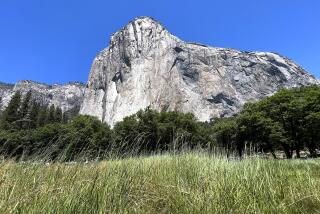Administration, Yellowstone Staff at Odds on Park Threats
- Share via
WASHINGTON -- The Bush administration, citing a report by Yellowstone National Park’s professional staff, is asking a United Nations committee to remove the park from a list of World Heritage sites that are “in danger” of losing their grandeur.
“Yellowstone is no longer in danger,” Paul Hoffman, an Interior Department official, wrote in an April 7 letter to the World Heritage Committee of the United Nations Educational, Scientific and Cultural Organization.
But there is one hitch: The professional staff appears to disagree with the administration’s assessment that the government is addressing all the problems that put Yellowstone on the endangered list in 1995. A draft report by the staff earlier this year identified continuing threats to the quality of the park’s streams, bison herd and cutthroat trout populations -- and to visitors’ overall experience of the park.
The final report sent to the international committee by the Bush administration had toned down or deleted these concerns. Copies of both reports were provided to the Los Angeles Times by the Greater Yellowstone Coalition, a regional conservation group.
Hoffman, deputy assistant interior secretary with responsibility for the national parks, said in an interview that the administration was not trying to “sugarcoat” Yellowstone’s condition. He stressed that the serious threats to the park had been or were being addressed.
Critics of the administration said its editing of the Yellowstone report resembled a recent White House effort to water down the global warming section of a report on the nation’s environment. That report was released Monday with only a brief mention of global warming because outgoing Environmental Protection Agency Administrator Christie Whitman considered the administration’s edited version unacceptable.
“Tinkering with scientific information, either striking it from reports or altering it, is becoming a pattern of behavior,” said Roger G. Kennedy, a former director of the National Park Service. “It represents the politicizing of a scientific process, which at once manifests a disdain for professional scientists working for our government and a willingness to be less than candid with the American people.”
The committee is expected to consider removing Yellowstone from the “in danger” list during its meeting in Paris next week.
The park’s version of the report, Hoffman said, identified new challenges not nearly as great as the dangers that put Yellowstone on the list.
“Those issues do not constitute a serious and imminent threat to the outstanding universal values for which Yellowstone is inscribed on the World Heritage list,” Hoffman said.
In 1995, Crown Butte Inc. was trying to reopen an old gold and silver mine on nearby forest land. An outdated sewage system at the park was sending large amounts of untreated waste into the park’s streams. A predatory, nonnative lake trout was threatening Yellowstone’s rare cutthroat trout. And large numbers of bison were being killed when they strayed outside park boundaries because ranchers feared they were carrying a disease called brucellosis.
Since then, Congress appropriated $65 million to acquire lands and mining claims and clean up toxic wastes from a century of mining. And Crown Butte agreed not to mine. Efforts were started to ease the threats to the bison and cutthroat and to update the sewage system.
But the park staff’s version points to threats not mentioned in the final version.
It notes that toxins from mining tailings not included in the cleanup agreement “continue to degrade waters” in Yellowstone. It says the results in the fight against the invasive lake trout are inconclusive and Yellowstone’s cutthroat trout face a new threat from whirling disease, a parasitic infection. And it says the jury is out on the effort to resolve the bison problem.
On the sewage problem, the park staff’s version mentions that smaller wastewater facilities in Yellowstone still need updating or replacement.
Leaving this information out of the report gives the World Heritage Committee a “deceptively bland assessment” of Yellowstone’s condition, Kennedy said in a letter to the committee urging it not to take Yellowstone off the list of endangered world treasures.
The Bush administration canceled a Clinton administration policy that would have phased out snowmobiles from Yellowstone this year. The Bush administration’s plan caps the number of snowmobiles allowed, but at a level higher than currently visit the park.
The administration decided to expand snowmobile use despite findings by the National Park Service that the vehicles cause environmental and health damage.
Michael Scott, executive director of the Greater Yellowstone Coalition, said taking Yellowstone off the list could make it harder for park service employees to protect the park’s resources.
Hoffman disagreed. “Yellowstone will always receive a high degree of attention from Congress, the administration and the American public for all the obvious reasons,” he said.
More to Read
Sign up for Essential California
The most important California stories and recommendations in your inbox every morning.
You may occasionally receive promotional content from the Los Angeles Times.










